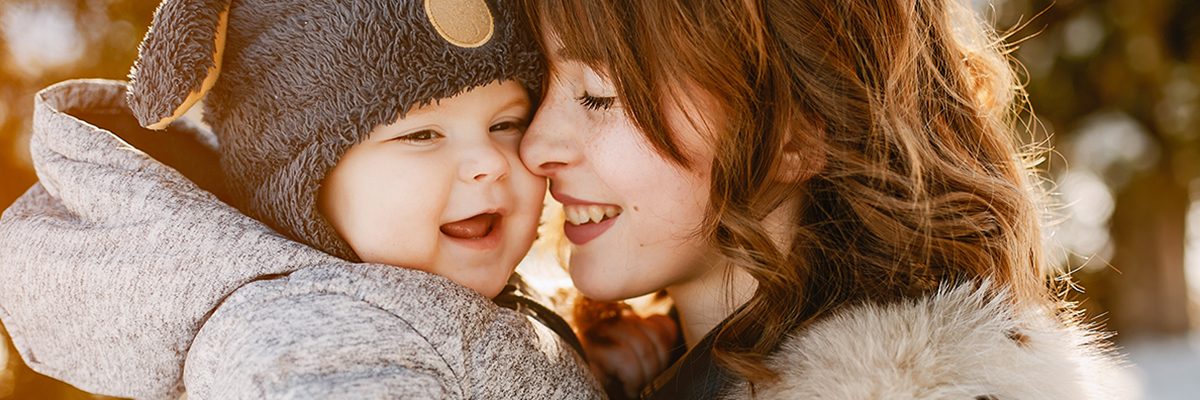Article at-a-glance
- Cold winter months make it so babies need help regulating their body temperature.
- As a rule of thumb, dress your baby in the same number of layers you would wear plus one.
- Bulky outerwear can interfere with the proper fit of car seat restraints.
Every season has safety issues when it comes to babies – winter is no exception. Yes, baby, it’s cold outside, but this is no reason to not enjoy the weather. Babies need help regulating their body temperature during cold days. The best guideline to remember; dress your little one in the same number of clothing layers you’re wearing PLUS ONE. Here are a few tips to keep your newborn comfortable.
Nurture Baby’s Skin
- Everyone tends to get dry during the winter, especially the skin. Prevent chapped areas by applying a thin layer of petroleum jelly to the exposed parts of your child’s face, the nose, lips, and chin. Check with your pediatrician for advice on other brands of skin protection creams.
- Invest in a cool-mist humidifier to keep the air comfortable and not too dry from home heaters.
Dressing Your Newborn for Winter Sleep
- Keep your thermostat at a comfortable setting between 65-70 degrees F.
- Dressing is all about layering.
- To check your baby’s core temperature, place your fingers at the nape of their neck. If your baby is pooling in sweat, she is too warm.
- Overheated babies are uncomfortable and have an increased risk of SIDS (Sudden Infant Death Syndrome). Other risks for SIDS include blankets in the crib.
- On the other hand, if your baby is too cold, he will be uncomfortable and may have trouble settling into sleep and waking frequently.
- Start with a cotton Onesie and then add a footed sleeper.
- You can swaddle your newborn in a light blanket like a “burrito”, but no extra blankets or stuffed toys in the bed. Err on the side of caution for suffocation.
- If your baby doesn’t like being swaddled too tight, consider placing her into a sleep sack. This is a triangular-type zippered piece of clothing; arms inside like a cardigan sweater or vest, but the torso and legs are free inside this roomy sack.
- Use breathable fabrics like cotton or wool. Fleece can be used outdoors, but sometimes too hot for indoor sleeping.
Going Outdoors with Baby in Winter
- Always think layers when dressing your newborn for the outdoors in winter – body heat is trapped within each layer, which is a good thing. A thermal bodysuit is a good clothing choice for retaining body heat in babies.
- Make sure your little one is always dry. Wet clothing can cause hypothermia. Also, check diapers often.
- If you are using a stroller, place your baby in a snowsuit or bunting bag (a sack that zips upfront). Lay him on a blanket-lined stroller seat and tuck another blanket around him.
- Make sure your baby is wearing a cotton or wool knit hat. Heat escapes through the head.
- A stroller shield (plastic or canvas cover) is a necessity on windy, snowy, or rainy days.
- Do not venture outdoors if the temperature is 20-degree F. or below.
Newborns and Automobile Car Seats
Parents tend to bundle babies and then wedge them into a car seat. This bulkiness interferes with the proper fit of car seat restraints. Straps should lie smoothly and snug across the child’s body.
“I always tell families that the straps shouldn’t be adjusted to accommodate coats. The coat should be removed if it can’t fit comfortably in the seat with your child.” – Dr. Doug Later
Alternatives to puffy outerwear:
- You can dress your baby in a fleece bodysuit for warmth. Use thin layers underneath.
- Tuck a blanket around him inside the car seat.
- A baby should wear a knit hat, as heat escapes from the head.
- Never use scarves, they can cover the face and are dangerous for newborns.
- Try a flannel poncho as outerwear. Place this over the child’s head. You can lift the poncho to attach the car seat straps correctly and then cover up the baby’s body with the poncho top flap. This is an alternative to a blanket.
Most importantly, make sure you have your child’s car seat inspected by professionals to make sure it is installed properly and the correct size for your baby’s size and weight.
Save
Save
Reviewed on October 7, 2019 by:

Dr. Later is a father of three boys, a die-hard Utah Jazz fan, and a lover of the outdoors. He has an interest in sports medicine and autism spectrum disorder. Languages: English, Spanish
Share this article:

